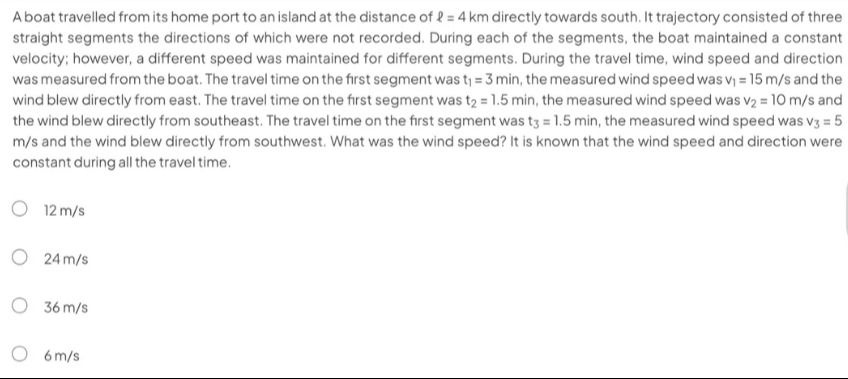Question
Question: A boat travelled from its home port to an island at the distance of $l = 4$ km directly towards sout...
A boat travelled from its home port to an island at the distance of l=4 km directly towards south. It trajectory consisted of three straight segments the directions of which were not recorded. During each of the segments, the boat maintained a constant velocity; however, a different speed was maintained for different segments. During the travel time, wind speed and direction was measured from the boat. The travel time on the first segment was t1=3 min, the measured wind speed was v1=15 m/s and the wind blew directly from east. The travel time on the first segment was t2=1.5 min, the measured wind speed was v2=10 m/s and the wind blew directly from southeast. The travel time on the first segment was t3=1.5 min, the measured wind speed was v3=5 m/s and the wind blew directly from southwest. What was the wind speed? It is known that the wind speed and direction were constant during all the travel time.

12 m/s
24 m/s
36 m/s
6 m/s
12 m/s
Solution
Solution
Let the true constant wind vector be W=(Wx,Wy) (in m/s). In each segment, the boat’s measured (apparent) wind is
ui=W−vi,so that
vi=W−ui.Step 1. Set up the relative wind vectors.
We use the convention: East +x, North +y.
-
Segment 1:
u1=(−15,0).
Measured wind: 15 m/s “from east” means the apparent wind comes from east, i.e.Thus,
v1=W−u1=W+(15,0)=(Wx+15,Wy). -
Segment 2:
u2=(−10/2,10/2).
Measured wind: 10 m/s “from southeast.”
“From southeast” means the apparent wind is arriving from southeast, so it points toward northwest. Since the southeast direction makes a 45° angle, we haveHence,
v2=W−u2=(Wx+210,Wy−210). -
Segment 3:
u3=(5/2,5/2).
Measured wind: 5 m/s “from southwest” means the apparent wind comes from southwest (pointing toward northeast). Thus,And,
v3=W−u3=(Wx−25,Wy−25).
Step 2. Use the displacement constraint.
The boat’s overall displacement is 4 km due South, i.e.,
Δr=(0,−4000) m.Convert times to seconds:
t1=3 min=180s,t2=t3=1.5 min=90s.The total displacement is:
r=v1t1+v2t2+v3t3.x-component:
0=180(Wx+15)+90(Wx+210)+90(Wx−25)=(180+90+90)Wx+180⋅15+90(210−25)=360Wx+2700+90(25)=360Wx+2700+2450.Thus,
Wx=−3602700+2450.y-component:
−4000=180Wy+90(Wy−210)+90(Wy−25)=(180+90+90)Wy−90(210+5)=360Wy−21350.So,
360Wy=−4000+21350,andWy=360−4000+21350.Step 3. Find the wind speed ∣W∣.
Calculate numerically (using 2≈1.414):
WxWy=−3602700+1.414450≈−3602700+318.2=−3603018.2≈−8.3839 m/s,≈360−4000+1.4141350=360−4000+955=360−3045≈−8.4583 m/s.Thus,
∣W∣=Wx2+Wy2≈(8.3839)2+(8.4583)2≈70.3+71.5≈141.8≈11.91m/s.This is very close to 12 m/s.
Answer: 12 m/s (Option 1)
Core Explanation:
Set up vector equations for each segment using W−vi=ui. Write the boat’s displacement (summing viti) and equate its x-component to 0 (since total displacement x = 0) and its y-component to −4000 m. Solve for Wx and Wy and then compute ∣W∣.
